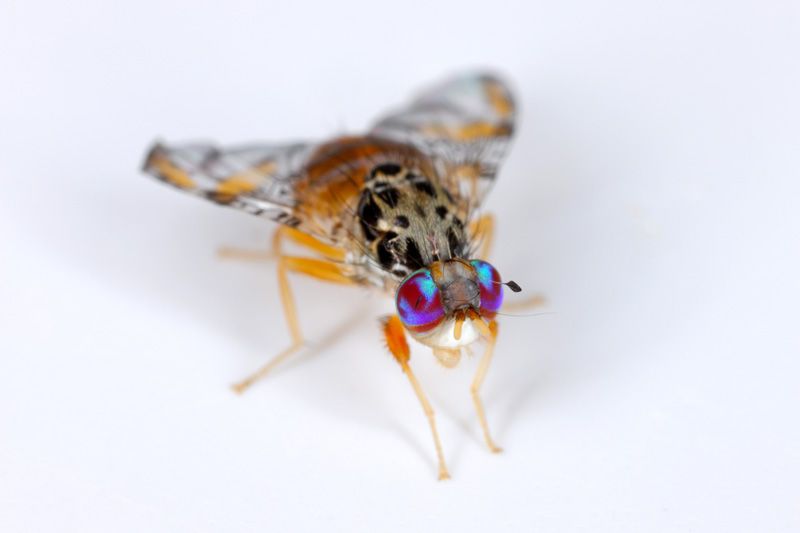
Mediterranean Fruit Fly – Ceratitis capitata
Mediterranean Fruit Fly – Ceratitis capitata
Description of Insect:
The Mediterranean fruit fly (Ceratitis capitata), often referred to as the Medfly, is one of the most destructive agricultural pests globally. Native to sub-Saharan Africa, this small, invasive fly has become a significant threat to fruit crops in tropical, subtropical, and even cooler climates.
Adult Mediterranean fruit flies measure around 3.5-5 mm in length and are covered with bristles. They are characterized by their yellowish-white thorax, brown abdomen, and distinct black markings on the wings. These markings, along with the fly’s characteristic scutellum help to distinguish the Medfly from other fruit fly species. The flies have large, reddish-purple eyes and long, segmented antennae, which they use to locate ripe fruit from long distances. Male and female flies can be easily distinguished based on the sexual shape dimorphism between the proximal and distal wings.
The Medfly is most notable for its devastating impact on fruit crops. The damage caused by this feeding makes the fruit unmarketable, leading to significant agricultural losses. The Mediterranean fruit fly is a polyphagous pest, meaning it can infest over 260 different types of fruits and vegetables. These include citrus, peaches, apples, grapes, and tomatoes, among others.
Life cycle of Mediterranean Fruit Fly
The Mediterranean fruit fly has a rapid life cycle that allows it to reproduce quickly and create large populations. Females can lay approximately 22 eggs per day and up to 800 eggs during their lifetime. Once the female lays her eggs under the skin of a ripening fruit, the eggs hatch into larvae. These tiny, white larvae burrow into the fruit, feeding on its flesh until they mature.
After 6-15 days, depending on the fruit species; the larvae exit the fruit, drop to the ground, and burrow into the soil to pupate. The pupal stage lasts for around 6-19 days, during which the larvae transform into adult flies. Upon emerging as adults, the Medflies search for new fruit to infest. This quick life cycle, with 7 to 8 generations occurring within a year, allows the Medfly to spread rapidly.
Damage they cause:
The Mediterranean fruit fly is responsible for extensive agricultural damage, particularly in regions that rely on fruit production. This invasive pest not only impacts the quantity of fruit harvested but also reduces the quality of the produce, making it unfit for sale in many markets.
- Economic Losses: The economic impact of the Mediterranean fruit fly is staggering. According to an estimate, the Medfly causes approximately $190 billion of losses each year in Mediterranean Basin countries due to crop destruction. Premature fruit drop, rotting, and distortion leads to decreased quality and market value. The cost of pest control and quarantine measures also adds to the financial burden.
- Impact on Trade: The Mediterranean fruit fly’s status as a quarantine pest has significant implications for international trade. Countries that export fruit to regions affected by the Medfly face strict regulations and inspections to ensure that their products are free of the pest. Infestations of the Mediterranean fruit fly in export countries can lead to trade restrictions, which can have serious consequences for agricultural economies. In some cases, entire industries may suffer, particularly in countries that rely on fruit exports for economic stability.
- Food Safety Concerns: The larvae of the Medfly can contaminate fruit with bacteria and pathogens, posing a potential health risk to consumers. In addition, damaged fruit provides an entry point for other pests and diseases, further compromising the safety and quality of the produce. This contamination not only affects the marketability of fruit but can also lead to public health concerns.
